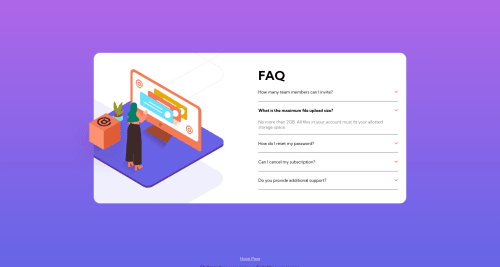responsive faq accordion card

Solution retrospective
Incredible challenge! I had great difficulties to finish, maybe it made it difficult to do some things, but, as always, I try to find the most practical way to complete the challenge, feedbacks are welcome!
Please log in to post a comment
Log in with GitHubCommunity feedback
- @Finney06
Hello there 👋. Good job on completing the challenge !
Here are some suggestions regarding your code that may be of interest to you.
HTML 🏷️:
To clear the Accessibility report:
The error message "
ulandolmust only directly containli,script, or template elements" typically appears when there is invalid HTML markup in the code. This error indicates that either an<ul>or<ol>element contains an element other than<li>,<template>elements as direct children.-
If you need to include other types of elements within a list, you can nest them within an
<li>element. -
Use a validator tool to check your HTML code for other possible errors.
Here's an example of valid HTML markup for an ordered list:
<ol> <li>Item 1</li> <li>Item 2</li> <li>Item 3</li> </ol>And here's an example of valid HTML markup for an unordered list:
<ul> <li>Item 1</li> <li>Item 2</li> <li>Item 3</li> </ul>By ensuring that your HTML markup follows the specifications, you can avoid errors and ensure that your web page is accessible to all users.
- The error message "All page content should be contained by landmarks" typically appears when the HTML code does not contain the necessary accessibility landmarks to help users navigate the content of the page. In this case, the
<div>element with class "attribution" is not a landmark or a footer element, and therefore it does not provide any navigation aid for users.
To fix this error, you can do the following:
-
Use HTML5 landmarks: HTML5 introduced several new elements that can be used to define the different sections of a web page, such as
<header>,<nav>,<main>,<aside>, and<footer>. By using these elements, you can create a clear hierarchy of content that is easy to navigate for users. -
Include a footer element: A footer element should be included at the end of the document and contain information about the website or document, such as copyright information or contact details.
I hope you find it helpful!😏 Above all, the solution you submitted is 👌. 🎉Happy coding!
Marked as helpful -
- @lucasmm56
Hello, thank you very much for the feedback, I will put it into practice right now!
Join our Discord community
Join thousands of Frontend Mentor community members taking the challenges, sharing resources, helping each other, and chatting about all things front-end!
Join our Discord